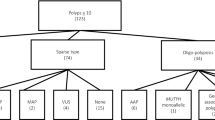Abstract
PURPOSE: Genotype-phenotype correlations in familial adenomatous polyposis are only partially understood and, in particular, little is known about the biomolecular characteristics of desmoid tumors, which are one of the most serious and frequent manifestations of familial adenomatous polyposis. In the present study, we describe a family with familial adenomatous polyposis, with peculiar clinical characteristics (i.e., frequency and severity of desmoid neoplasms) associated with an unusual mutation of the adenomatosis polyposis coli gene. If confirmed by other investigations, these findings might help to understand the biologic mechanisms by which specific adenomatosis polyposis coli mutations predispose to desmoid tumors. METHODS: The family with familial adenomatous polyposis, living in southern Italy, was studied from 1985 to the end of 1999; at this date, 15 individuals have been affected by histologically verified familial adenomatous polyposis, 11 of whom had desmoid tumors. A total of 19 family members were studied for adenomatosis polyposis coli gene mutations; 13 of them tested positive and 6 negative. The analytical procedure—previously described—consisted of the extraction of peripheral blood cell DNA, amplification of exon 15 by polymerase chain reaction, single-strand conformation polymorphism analysis, and direct sequencing of the DNA fragment containing the mutation. RESULTS: The main clinical features of the family were 1) a high frequency of desmoid tumors and, consequently, a high penetrance of the desmoid trait in all branches of the family and in 11 (73.3 percent) of 15 affected individuals and 2) severity of desmoids in at least 4 family members, 2 of whom died for causes related to the presence of these tumors. The molecular basis of the disease was an uncommon mutation of the adenomatosis polyposis coli gene, consisting of a large deletion of 310 base pairs at codon 1,464, with duplication of the breakpoint (4,394ins15del310), leading to a stop codon at position 1,575. CONCLUSIONS: The present study shows that a truncating mutation in the adenomatosis polyposis coli gene at the beginning of the region frequently associated with desmoids induced a familial adenomatous polyposis phenotype featured by a high penetrance of the desmoid trait, with severe disease in several affected members of both sexes. The study may help to understand the biologic mechanisms of genotype-phenotype correlations in adenomatosis coli.
Similar content being viewed by others
References
Naylor EW, Lebenthal E. Gardner's syndrome: recent development in research and management. Dig Dis Sci 1980;25:945–59.
Rhodes M, Bradburn DM. Overview of screening and management of familial adenomatous polyposis. Gut 1992;33:125–31.
Nugent KP, Phillips RK, Hodgson SV,et al. Phenotypic expression in familial adenomatous polyposis: partial prediction by mutation analysis. Gut 1994;35:1622–3.
Nance FC. Management strategies for familial adenomatous polyposis. Ann Surg 1993;217:99–100.
Kinzler KW, Nilbert MC, Su LK,et al. Identification of FAP locus genes from chromosome 5q21. Science 1991;253:661–5.
Joslyn G, Carlson M, Thliveris A,et al. Identification of deletion mutations and three new genes at the familial polyposis locus. Cell 1991;66:601–13.
Rubinfeld B, Souza B, Albert I,et al. Association of the APC gene product with β-catenin. Science 1993;262:1731–4.
Su LK, Vogelstein B, Kinzler KW,et al. Association of the APC tumor suppressor protein with catenins. Science 1993;262:1734–7.
Munemitsu S, Souza B, Müller O,et al. The APC gene product associates with microtubules in vivo and promotes their assembly in vitro. Cancer Res 1994;54:3676–81.
Olschwang S, Laurent-Puig P, Groden J,et al. Germ-line mutations in the first 14 exons of the adenomatous polyposis coli (APC) gene. Am J Hum Genet 1993;52:273–9.
Wu JS, Paul P, McGannon EA,et al. APC genotype, polyp number, and surgical options in familial adenomatous polyposis. Ann Surg 1998;227:57–62.
Presciuttini S, Gismondi V, Scarsello E,et al. Different expressivity of two adjacent mutations of the APC gene. Tumori 1999;85:28–31.
Heinimann K, Müllhaupt B, Weber W,et al. Phenotypic differences in familial adenomatous polyposis based on APC gene mutation status. Gut 1998;43:675–9.
Jones IT, Jagelman DG, Fazio VW,et al. Desmoid tumors in familial polyposis coli. Ann Surg 1986;204:94–7.
Ballo MT, Zagars GK, Pollack A,et al. Desmoid tumor: prognostic factors and outcome after surgery, radiation therapy, or combined surgery and radiation therapy. J Clin Oncol 1999;17:158–67.
Caspari R, Olschwang S, Friedl W,et al. Familial adenomatous polyposis: desmoid tumours and lack of ophthalmic lesions (CHRPE) associated with APC mutations beyond codon 1444. Hum Mol Genet 1995;4:337–40.
Gebert JF, Dupon C, Kadmon M,et al. Combined molecular and clinical approaches for the identification of families with familial adenomatous polyposis coli. Ann Surg 1999;229:350–61.
Gurbuz AK, Giardiello FM, Petersen GM,et al. Desmoid tumors in familial adenomatous polyposis. Gut 1994;35:377–81.
Gismondi V, Bafico A, Biticchi R,et al. 310 basepair APC deletion with duplication of breakpoint (4394ins15del310) in an Italian polyposis patient. Hum Mut 1998;1(Suppl):S220-S2.
Varesco L, Gismondi V, James R,et al. Identification of APC gene mutations in Italian adenomatous polyposis coli patients by PCR-SSCP analysis. Am J Hum Genet 1993;52:280–5.
Sambrook J, Fritsch EF, Maniatis T,et al. Molecular cloning: a laboratory manual. 2nd ed. Cold Spring Harbor: Cold Spring Harbor Laboratory Press, 1989.
Samowitz WS, Thliveris A, Spirio LN,et al. Alternatively spliced adenomatous polyposis coli (APC) gene transcripts that delete exons mutated in attenuated APC. Cancer Res 1995;55:3732–4.
Ponz de Leon M, Benatti P, Percesepe A,et al. Clinical features and genotype-phenotype correlations in 41 Italian families with adenomatosis coli. Ital J Gastroenterol Hepatol 1999;31:850–60.
Pedemonte S, Sciallero S, Gismondi V,et al. Novel germline APC variants in patients with multiple adenomas. Genes Chromosomes Cancer 1998;22:257–67.
Lewis JJ, Boland PJ, Leung DH,et al. The enigma of desmoid tumors. Ann Surg 1999;229:866–73.
Weiss AJ, Horowitz D, Lackmen RD. Therapy of desmoid tumors and fibromatosis using vinorelbine. Am J Clin Oncol 1999;22:193–5.
De Pietri S, Sassatelli R, Roncucci L,et al. Clinical and biologic features of adenomatosis coli in Northern Italy. Scand J Gastroenterol 1995;30:771–9.
Itoh H, Ikeda S, Oohata Y, Iida M, Inoue T, Onitsuka H. Treatment of desmoid tumors in Gardner's syndrome: report of a case. Dis Colon Rectum 1988;31:459–61.
Giarola MN, Wells D, Mondini P,et al. Mutations of adenomatous polyposis coli (APC) gene are uncommon in sporadic desmoid tumours. Br J Cancer 1998;78:582–7.
Bresinger JD, Laken SJ, Luce MC,et al. Variable phenotype of familial adenomatous polyposis in pedigrees with 3′ mutation in the APC gene. Gut 1998;43:548–52.
Eccles DM, van der Luijt R, Breukel C,et al. Hereditary desmoid disease due to a frameshift mutation at codon 1924 of the APC gene. Am J Hum Genet 1996;59:1193–201.
Laken SJ, Papadopoulos N, Petersen GM,et al. Analysis of masked mutations in familial adenomatous polyposis. Proc Natl Acad Sci USA 1999;96:2322–6.
De Rosa M, Scarano MI, Panariello L,et al. Three submicroscopic deletions at the APC locus and their rapid detection by quantitative-PCR analysis. Eur J Hum Genet 1999;7:695–703.
Rozen P, Samuel Z, Shomrat R,et al. Notable intrafamilial phenotypic variability in a kindred with familial adenomatous polyposis and an APC mutation in exon 9. Gut 1999;45:829–33.
Howe JR, Guillem JG. The genetics of colorectal cancer. Surg Clin North Am 1997;77:175–95.
Lynch HT, Smyrk T, McGinn T,et al. Attenuated familial adenomatous polyposis (AFAP). Cancer 1995;76:2427–33.
Caspari R, Friedl W, Mandl M,et al. Familial adenomatous polyposis: mutation at codon 1309 and early onset of colon cancer. Lancet 1994;343:629–32.
Spirio L, Joslyn G, Nelson L,et al. A CA repeat 30–70 KB downstream from the adenomatous polyposis coli (APC) gene. Nucleic Acids Res 1991;19:6348.
Behrends J, Jerchow BA, Wurtele M,et al. Functional interaction of an axon homolog, conductin, with b-catenin, APC, and GSK3b. Science 1998;280:596–9.
Smits R, van der Houven van Oordt W, Luz A,et al. Apc1638N: a mouse model for familial adenomatous polyposis-associated desmoid tumors and cutaneous cysts. Gastroenterology 1998;114:275–83.
Waddell WR, Gerner RE, Reich MP. Nonsteroidal anti-inflammatory drugs and tamoxifen for desmoid tumors and carcinoma of the stomach. J Surg Oncol 1983;22:197–211.
Brooks MD, Ebbs SR, Colletta AA,et al. Desmoid tumors treated with triphenylethylenes [abstract]. Eur J Cancer 1992;28A:1014–8.
Schnitzler M, Cohen Z, Blackstein M,et al. Chemotherapy for desmoid tumors in association with familial adenomatous polyposis. Dis Colon Rectum 1997;40:798–801.
Author information
Authors and Affiliations
Additional information
Supported, in part, by grants from the Italian Ministry of the Education and University (funds 60 and 40 percent), the Consiglio Nazionale delle Ricerche (CNR project “Applicazioni Cliniche della Ricerca Oncologica”), the Associazione Italiana per la Ricerca sul Cancro (special project “Hereditary Colorectal Cancer,” 1994–1997 and funds of 1998), and the Region Emilia-Romagna (legge 1970, 15.3.1986).
About this article
Cite this article
de Leon, M.P., Varesco, L., Benatti, P. et al. Phenotype-genotype correlations in an extended family with adenomatosis coli and an unusual APC gene mutation. Dis Colon Rectum 44, 1597–1604 (2001). https://doi.org/10.1007/BF02234378
Issue Date:
DOI: https://doi.org/10.1007/BF02234378




